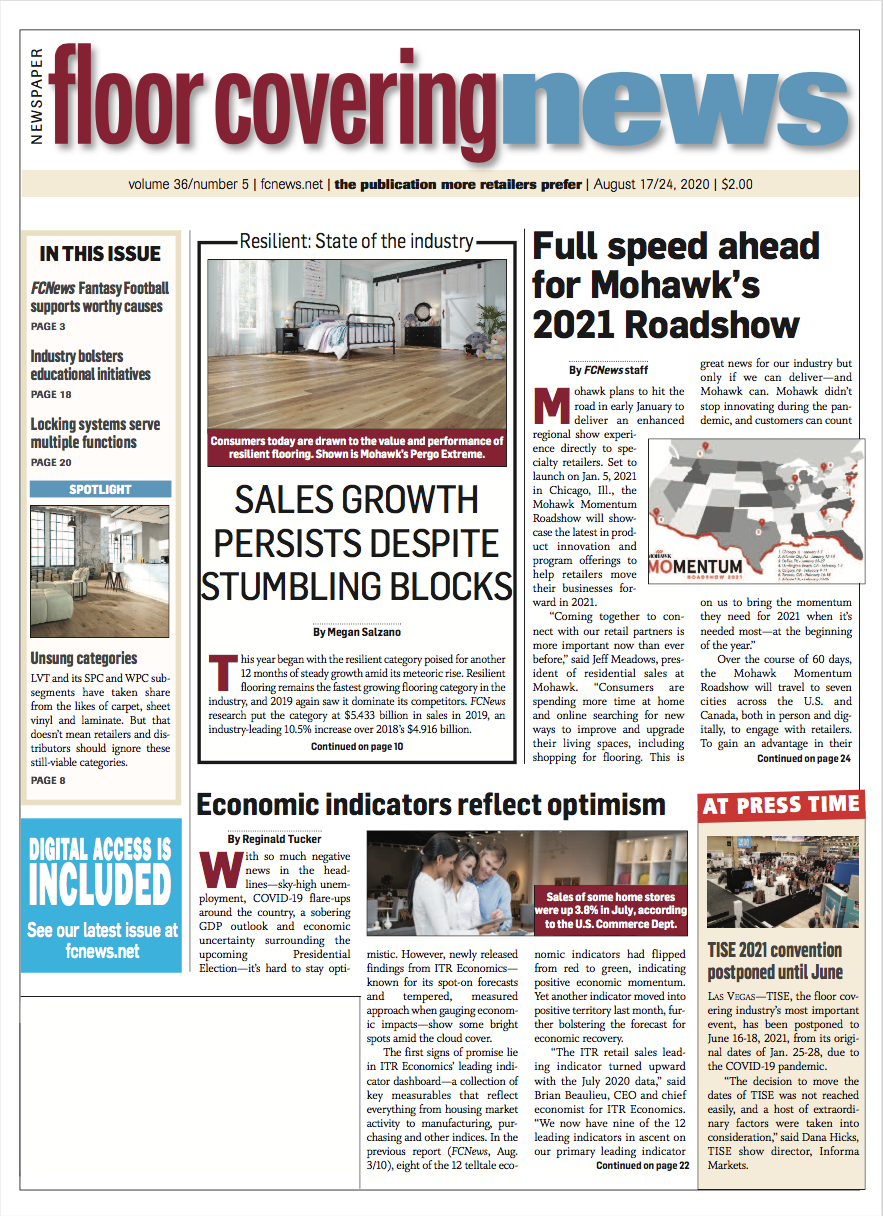By Reginald Tucker

With so much negative news in the headlines—sky-high unemployment, COVID-19 flare-ups around the country, a sobering GDP outlook and economic uncertainty surrounding the upcoming Presidential Election—it’s hard to stay optimistic. However, newly released findings from ITR Economics—known for its spot-on forecasts and tempered, measured approach when gauging economic impacts—show some bright spots amid the cloud cover.
The first signs of promise lie in ITR Economics’ leading indicator dashboard—a collection of key measurables that reflect everything from housing market activity to manufacturing, purchasing and other indices. In the previous report (FCNews, Aug. 3/10), eight of the 12 telltale economic indicators had flipped from red to green, indicating positive economic momentum. Yet another indicator moved into positive territory last month, further bolstering the forecast for economic recovery.
“The ITR retail sales leading indicator turned upward with the July 2020 data,” said Brian Beaulieu, CEO and chief economist for ITR Economics. “We now have nine of the 12 leading indicators in ascent on our primary leading indicators in ascent on our primary leading indicator dashboard.”
That jibes with newly released Commerce Dept. stats, which show June monthly retail sales came in 2.7% above June 2019 (see sidebar on page 23). This despite double-digit unemployment rates and a partially shuttered U.S. economy. “Retail sales are trending above the upper end of the forecast range, but there are sufficient down-side risks—particularly delays in reopening the economy and the expiration of certain unemployment benefits,” Beaulieu noted. “We expect the retail sales 12 month moving total (MMT) to decline into the early months of 2021 and then rise through at least the end of 2022.”
Closely aligned to retail sales activity is the monthly U.S. personal savings rate. ITR Economics research showed this metric recorded its respective highest and second-highest readings in April and May as consumers set aside part of the stimulus money they received. The benefit? “Today’s savings can be spent tomorrow,” Beaulieu said. “The savings rate bodes well for the future recovery trend in retail sales.”
Following is a summary of several other key indicators:
U.S. total industry capacity utilization rate 1/12 rose from May to June, posting the sharpest monthly rise in the 50- plus years of tracking. If it holds, the tentative April 2020 rate 1/12 low puts U.S. industrial activity on track to recover head- ing into 2021. “The primary risk to the low holding is the possibility of more significant and widespread reversal of states’ reopening,” Beaulieu said.
The U.S. Conference Board’s leading indicator 1/12 rose in June, further supporting a tentative April low. “This points to an early 2021 transition to recovery for U.S. industrial production, consistent with our expectations,” Beaulieu said, but warned, “The potential for extended shutdowns poses continued risk to this recovery.”
The U.S. purchasing managers index 1/12 posted a third consecutive month of increases. “The rise gives further credence to our expectation for an early-2021 low and subsequent rise for the U.S. industrial production 12/12,” Beaulieu said.
One area where ITR is hoping the market will show more positive movement across the board is housing. After posting double-digit declines relative to year-ago levels in both April and May, monthly U.S. single-digit housing starts in June came in a comparatively mild 1.6% below the June 2019 level. ITR said it expects a decline in starts for the remainder of this year with a rebound throughout 2021 and 2022.
“Our analysis suggests results are likely to continue to track at slightly below the lower end of the forecast range in the near term,” Beaulieu said. “However, monthly U.S. single-unit housing permits and the monthly National Association of Home Builders Housing Market Index were up double digits in June relative to their respective June 2019 levels. Positive momentum in these leading indicators, combined with very low mortgage rates and low home inventories, led us to keep the existing forecast in place.”
While it’s not quite ready yet to signal “rise” for its leading indicators dashboard, ITR said it finds the year-over-year increase in single-family housing permits encouraging. The reason? Recent data showing June 2020 permits coming in 11.3% above the June 2019 level. “Coupled with the strong retail sales data for June, this is another sign that consumers have more than a pulse—they are out in the economy making things happen,” Beaulieu said.
By comparison, multi-family starts in the month of June were 5% below June of 2019. This follows on the heels of 30%-plus declines for each of the prior two months.
Much like housing, ITR Economics is closely watching U.S. industrial production trends. Statistics show U.S. industrial production during the second quarter of 2020 was down 13.4% from the first quarter. And despite an 8.1% rise in monthly production from May to June, delays and reversals in state reopenings are concerning for the second half of 2020, Beaulieu noted.
However, on a positive note, industrial production in June rose a stronger-than-normal 8.1% from May as the economy worked to regain its strong footing. “We anticipate that while noticeable rise will characterize the production 12MMA in most of 2021 and all of 2022, the economy will not return to the August 2019 record level during this time,” Beaulieu said.
All in all, ITR said it remains optimistic about the prospects for a steady recovery. “The majority of key leading indicators are signaling that the industrial and retail sectors will transition to recover trends during the first half of 2021,” Beaulieu said. “We can expect recovery in both wholesale trade of durable and nondurable goods to follow as activity and prices rise. U.S. non-defense capital goods new orders are trending above the upper end of the forecast range and likely to be above expectations in the near term. However, we think it would be unwise to upgrade our new orders expectations given the leading indicator evidence to date and the number of states that are reversing or delaying reopenings.”

